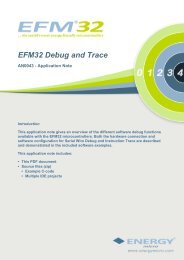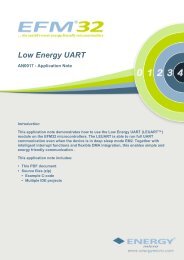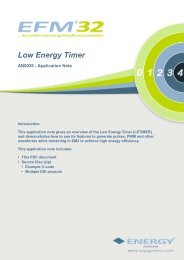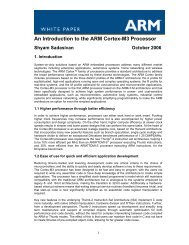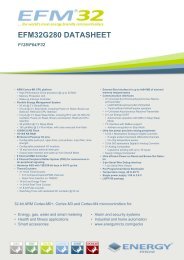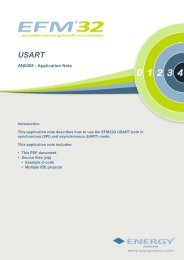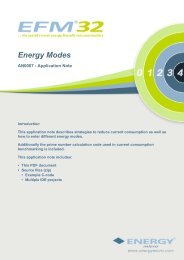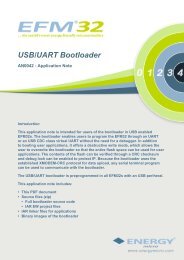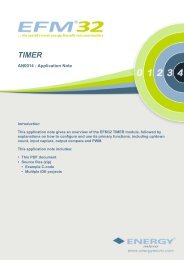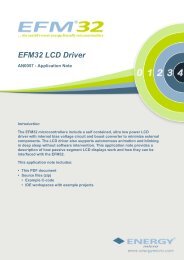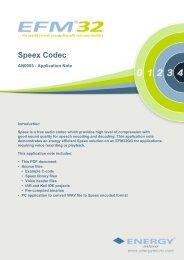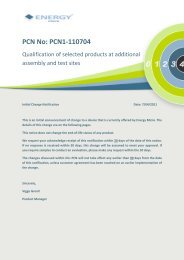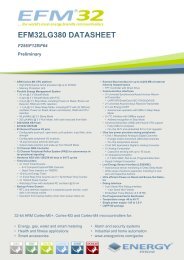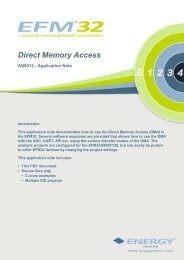Digital to Analog Converter - AN0022 - Application ... - Energy Micro
Digital to Analog Converter - AN0022 - Application ... - Energy Micro
Digital to Analog Converter - AN0022 - Application ... - Energy Micro
You also want an ePaper? Increase the reach of your titles
YUMPU automatically turns print PDFs into web optimized ePapers that Google loves.
...the world's most energy friendly microcontrollers<strong>Digital</strong> <strong>to</strong> <strong>Analog</strong> <strong>Converter</strong><strong>AN0022</strong> - <strong>Application</strong> NoteIntroductionThis application note describes how <strong>to</strong> use the EFM32 <strong>Digital</strong> <strong>to</strong> <strong>Analog</strong> <strong>Converter</strong>.The features of the <strong>Digital</strong> <strong>to</strong> <strong>Analog</strong> <strong>Converter</strong> are described, and the softwareexamples include both a signal genera<strong>to</strong>r and audio playback using Direct MemoryAccess.This application note includes:• This PDF document• Source files (zip)• Example C-code• Multiple IDE projects
1 <strong>Digital</strong> <strong>to</strong> <strong>Analog</strong> <strong>Converter</strong>1.1 Introduction...the world's most energy friendly microcontrollersThe EFM32 DAC is a 12 bit rail <strong>to</strong> rail <strong>Digital</strong> <strong>to</strong> <strong>Analog</strong> converter with either two single ended outputs,or one differential output. The maximum conversion rate is 500 ksamples/s at 12 bits resolution. Oneof the DAC's internal bandgap references or the VDD voltage can be selected as reference. The DACmay be used for a number of different applications such as sensor interfaces, voltage generation orsound/signal output.This application note shows general operation and usage of the DAC. In addition the sine genera<strong>to</strong>rmode is described and the different conversion modes are explained. The software examples includeboth an advanced signal genera<strong>to</strong>r and audio playback that both use DMA (Direct Memory Access) andthe PRS (Peripheral Reflex System).1.2 OverviewFigure 1.1. <strong>Digital</strong> <strong>to</strong> <strong>Analog</strong> <strong>Converter</strong> OverviewCH0DATACh 0DACn_OUT0CH1DATACh 1DACn_OUT11.25 V2.5 VVDDADCREFSELIn Figure 1.1 (p. 2) , the two data registers and the reference selection register are shown in grey.The DAC has a single reference selection for both channels. The output can be routed <strong>to</strong> the ADC andoutput on a pin at the same time.2013-05-08 - an0022_Rev1.09 2 www.energymicro.com
2 General Operation2.1 Clock Prescaling...the world's most energy friendly microcontrollersThe DAC clock is supplied by a DAC-clock prescaler which divides the peripheral clock (HFPERCLK)by a fac<strong>to</strong>r of 2 n between 1 and 128. The resulting DAC_CLK is used by the converter core and thefrequency is given by Equation 2.1 (p. 3) :Clock Prescalingf DAC_CLK = f HFPERCLK / 2 ^ PRESC (2.1)where f HFPERCLK is the HFPERCLK frequency. One conversion takes 2 DAC_CLK cycles and theDAC_CLK should not be set higher than 1 MHz. This is taken care of when using the emlib functionfor calculating the prescaler.Normally the PRESCALER runs continuously when either of the channels are enabled. When runningwith a prescaler setting higher than 0, there will be an unpredictable delay from the time the conversionwas triggered <strong>to</strong> the time the actual conversion takes place. This is because the conversions is controlledby the prescaled clock and the conversion can arrive at any time during a prescaled clock (DAC_CLK)period. However, if the CH0PRESCRST bit in DACn_CTRL is set, the prescaler will be reset every timea conversion is triggered on channel 0. This leads <strong>to</strong> a predictable latency between channel 0 triggerand conversion.2.2 Output SelectionThe 2 single ended outputs of the DAC can either be used as two separate channels, or combined <strong>to</strong>form one differential output channel by setting the DIFF bit in DACn_CTRL.2.2.1 Single Ended ModeWhen operating in single ended mode, the channel 0 output is on DACn_OUT0 and the channel 1 outputis on DACn_OUT1. The output voltage can be calculated using Equation 2.2 (p. 3)Single Ended Output VoltageV OUT = V DACn_OUTx - V SS = V ref x CHxDATA/4096 (2.2)where CHxDATA is a 12-bit unsigned integer.2.2.2 Differential ModeWhen operating in differential mode, both DAC outputs are used for the differential voltage. Thedifferential conversion uses DACn_CH0DATA as source. The positive output is on DACn_OUT1 andthe negative output is on DACn_OUT0. Since the output can be negative, it is expected that the data iswritten in 2’s complement form with the MSB of the 12-bit value being the sign bit. The output voltagecan be calculated using Equation 2.3 (p. 3) :Differential Output VoltageV OUT = V DACn_OUT1 - V DACn_OUT0 = V ref x CH0DATA/2048 (2.3)where CH0DATA is a 12-bit signed integer. The common mode voltage is V ref /2.2.3 Reference SelectionThree internal voltage references are available and are selected by setting the REFSEL bits inDACn_CTRL:2013-05-08 - an0022_Rev1.09 3 www.energymicro.com
...the world's most energy friendly microcontrollers• Internal 2.5V• Internal 1.25V• V DDThe reference selection should only be changed while both channels are disabled. The references forthe DAC need <strong>to</strong> be enabled for some time before they can be used. This is called the warm-up period,and starts when one of the channels is enabled. For a bandgap reference, this period is 5 DAC_CLKcycles while the V DD reference needs 1 DAC_CLK cycle. The DAC will time this period au<strong>to</strong>matically(given that the prescaler is set correctly) and delay any conversion triggers received during the warmupuntil the references have stabilized.The bias current of the bandgap reference and the DAC output buffer can be scaled by writing theBIASPROG and HALFBIAS bit fields of the DACn_BIASPROG register. To be sure the DAC has thecharacteristics stated in the datasheet within the specified frequency range, the default values for thebias currents should be used.2.4 Conversion ModeThe DAC supports three different conversion modes, continuous, sample-hold and sample-off. Byselecting sample-hold or sample-off mode the power consumption can be reduced compared <strong>to</strong>continuous mode since the DAC is shut off between new samples or output refresh cycles.2.4.1 Continuous ModeIn continuous mode the DAC channels will drive their outputs continuously with the data in theDACn_CHxDATA registers. This mode will maintain the output voltage and refresh is therefore notneeded. Since the continuous mode makes the DAC convert constantly, this mode consumes the mostpower.2.4.2 Sample-Hold ModeIn sample-hold mode, the DAC converts data on a triggered conversion and then holds the output at theconverted voltage. When not converting between samples, the DAC core is turned off, which reducesthe energy consumption. Because of holding element leakage, the output voltage will drift if the outputis not refreshed by the DAC. The drift rate is specified in the datasheet.A refresh of the channel will happen when a new value is written <strong>to</strong> the DACn_CHxDATA register.Au<strong>to</strong>matic refresh can also be enabled by setting the bit REFREN in DACn_CHxCTRL. The refreshperiod can be selected by changing the REFRSEL value in the DACn_CTRL register. 4 different refreshperiods can be selected, a longer period will be more energy efficient, while a shorter period gives lessvoltage drift.Since the refresh period is defined by a number of DAC clock cycles, the refresh interval will bedependent on the DAC clock speed.2.4.3 Sample-Off ModeIn sample-off mode the DAC and the sample-hold element are turned completely off between samples,tristating the DAC output. This requires the DAC output voltage <strong>to</strong> be held externally. The referencesare also turned off between samples, which means that a new warm-up period is needed before eachconversion. The DAC will time this period au<strong>to</strong>matically and delay any conversion triggers receivedduring the warm- up until the references have stabilized.2.5 Conversion StartThe DAC channel must be enabled before it can be used. When the channel is enabled, a conversioncan be started by writing <strong>to</strong> the DACn_CHxDATA register. These data registers are also mapped in<strong>to</strong>2013-05-08 - an0022_Rev1.09 4 www.energymicro.com
...the world's most energy friendly microcontrollersa combined data register, DACn_COMBDATA, where the data values for both channels can be writtensimultaneously. Writing <strong>to</strong> this register will start a conversion on all enabled channels.If the PRSEN bit in DACn_CHxCTRL is set, a DAC conversion on channel x will not be started by datawrite, but when a positive one HFPERCLK cycle pulse is received on the PRS input selected by PRSSELin DACn_CHxCTRL.The CH0DV and CH1DV bits in DACn_STATUS are set high when the corresponding channel containsdata that has not yet been converted.2013-05-08 - an0022_Rev1.09 5 www.energymicro.com
3 Advanced Features...the world's most energy friendly microcontrollers3.1 Sine Genera<strong>to</strong>r ModeThe DAC contains an au<strong>to</strong>matic sine genera<strong>to</strong>r mode, which is enabled by setting the SINEMODE bitin the DACn_CTRL register. In this mode, the DAC data registers are overridden with conversion datataken from a hardware sine lookup table. The lookup table consist of 16 samples. When the OUTENPRSbit in DACn_CTRL is cleared, the sine genera<strong>to</strong>r will output the next sine-sample when a PRS conversiontrigger pulse is received. This is illustrated in Figure 3.1 (p. 6) .Figure 3.1. Sine Genera<strong>to</strong>r Mode with PRS-triggered SamplesOne PRS HFCLK PulsePRS pulse period changedCH0 PRSDACn_OUT0Sine Sam plesBy having a timer supply the PRS pulses on compare or overflow the frequency of the sine wave canbe accurately controlled.If the OUTENPRS bit is set, the PRS channels selected by PRSSEL in DACn_CH0CTRL andDACn_CH1CTRL switches on and off the sine wave (CH0 PRSSEL) and output driver (CH1 PRSSEL).The sine genera<strong>to</strong>r will now trigger new conversions by itself. If the channel 0 PRS line is low, a voltageof Vref/2 will be produced. When the line is high, the sine wave will be produced. The PRS line selectedfor channel 1 controls the output-driver which is tristated when the PRS line is low. This is illustratedin Figure 3.2 (p. 7) .The frequency when the OUTENPRS bit is set is given by Equation 3.1 (p. 6) :Sine Generation with OUTENPRS bit setf sine = f HFPERCLK / 32 x (PRESC + 1) (3.1)The sine wave will be output on channel 0. If the DIFF bit is set in DACn_CTRL, the sine wave will beoutput on both channels (if enabled), but inverted on the second channel (see Figure 3.2 (p. 7) ).Note that when OUTENPRS in DACn_CTRL is set, the sine output will be reset <strong>to</strong> 0 degrees when thePRS line selected by CH0PRSSEL is low.2013-05-08 - an0022_Rev1.09 6 www.energymicro.com
Figure 3.2. Sine Generation with OUTENPRS bit setCH0 PRS...the world's most energy friendly microcontrollersCH1 PRSVrefDACn_OUT1Hi-ZVref/20VrefDACn_OUT0Hi-ZVref/20In Figure 3.2 (p. 7) , when the OUTENPRS bit in DACn_CH0CTRL is set, the PRS-lines selectedby CH0PRSSEL and CH1PRSSEL enables the output driver and starts or s<strong>to</strong>ps the sine genera<strong>to</strong>r.3.2 Peripheral Reflex System and InterruptsBoth DAC channels have separate interrupt flags (in DACn_IF) indicating that a conversion has finishedon the channel and that new data can be written <strong>to</strong> the data registers. Setting one of these flags will resultin a DAC interrupt request if the corresponding interrupt enable bit is set in DACn_IEN. All generatedinterrupt requests from the DAC will activate the same interrupt vec<strong>to</strong>r when enabled.The DAC has two PRS outputs which will carry a one cycle (HFPERCLK) high pulse when thecorresponding channel has finished a conversion.3.3 Direct Memory AccessIn addition <strong>to</strong> the PRS output, the DAC sends out a DMA request when a conversion on a channel iscomplete. This request is cleared when the corresponding channel´s data register or the COMBDATAregister is written.3.4 CalibrationThe DAC contains a calibration register, DACn_CAL, where calibration values for both offset and gaincorrection can be written. Offset calibration is done separately for each channel through the CHxOFFSETbitfields. Gain is calibrated in one common register field, GAIN.The calibration values are linked <strong>to</strong> the reference and when the reference is changed, the correctcalibration values should be written <strong>to</strong> the calibration register. Gain and offset for the 1V25, 2V5 andVDD references are calibrated during production and the calibration values for these can be found inthe Device Information page. The correct calibration values are loaded au<strong>to</strong>matically when using theemlib for configuring the DAC.The DAC can also be calibrated manually. Either the internal ADC or an external voltage meter can beused <strong>to</strong> measure the DAC output voltage. If the ADC is used, it should be calibrated first as describedin the AN0021 - ADC application note. The procedure for calibrating the DAC is similar <strong>to</strong> the ADCcalibration procedure.• Offset is calibrated first by converting the value 0, and changing the calibration register until the outputequals 0 V. The algorithm should take in<strong>to</strong> account that the offset might be far below 0, but the outputwill still be 0.2013-05-08 - an0022_Rev1.09 7 www.energymicro.com
...the world's most energy friendly microcontrollers• Gain should be calibrated after offset by converting the <strong>to</strong>p value: 2 12 -1 and adjusting the gaincalibration register until the output almost equals the reference value (1-2 LSB's below) in order <strong>to</strong>avoid overshoot.2013-05-08 - an0022_Rev1.09 8 www.energymicro.com
4 Software Examples...the world's most energy friendly microcontrollers4.1 Programmable Voltage SourceThis example configures the DAC in continuous mode and converts a single value continuously. Byentering EM1 the DAC operates independently. Since the DAC is operating in continuous mode, theoutput voltage will be stable even if the output is loaded. The fact that the DAC is continuously workingwill be reflected by the power consumption.4.2 Sample-Hold Mode with Au<strong>to</strong>matic RefreshThis example basically does exactly the same thing as the first example, but now with the sample-holdmode which causes the DAC <strong>to</strong> be disabled between conversions. The internal output stage will holdthe output value while the DAC is shut off for a number of cycles. The refresh rate which controls howoften the DAC is woken up <strong>to</strong> refresh the holding element is adjustable.4.3 Sine Genera<strong>to</strong>r Mode with TimerThis example demonstrates how <strong>to</strong> use a timer <strong>to</strong> send PRS-pulses which in turn triggers new DACconversions. The DAC is configured in Sine Genera<strong>to</strong>r Mode. A sine wave with variable frequency isavailable on the DAC output pins. The frequency is adjusted by changing the timer overflow value. Afterconfiguration, energymode 1 is entered <strong>to</strong> save power.4.4 Signal Genera<strong>to</strong>rThe Signal Genera<strong>to</strong>r shows how TIMER0, PRS, DMA and the DAC can be used in cooperation <strong>to</strong>generate different glitch-free waveforms from tables in flash memory. The example code only works onthe DK because it uses the joystick and the but<strong>to</strong>ns <strong>to</strong> change the signal parameters. It can be easilymodified <strong>to</strong> work on other platforms than the DK, but without the user interface.The DMA is configured in ping pong mode <strong>to</strong> be able <strong>to</strong> supply new data <strong>to</strong> the DAC continuously withoutsoftware intervention between memory-buffer changes. New DAC samples are triggered by a PRS-pulsefrom the Timer. The DAC sends DMA-requests immediately after a conversion <strong>to</strong> have a new data valueready for the next PRS-pulse.The signal genera<strong>to</strong>r can operate in both fixed and variable sampling frequency mode. In the fixedsampling frequency mode, the amount of samples used for each period of the signal is adjusted <strong>to</strong>match the desired signal frequency. In variable sampling frequency mode the time between PRS-pulsesis adjusted and each signal period is made up of a fixed number of samples. Because of the limitedamount of look up table samples available for each cycle, the frequency in fixed sampling frequencymode can not be adjusted as accurately as in the variable sampling frequency case. The fixed samplingfrequency case is illustrated in Figure 4.1 (p. 10) , while an example of variable sampling frequencycan be seen in Figure 3.1 (p. 6) .2013-05-08 - an0022_Rev1.09 9 www.energymicro.com
...the world's most energy friendly microcontrollersFigure 4.1. Fixed Sampling FrequencyFixed Sam pling IntervalsCH0 PRSDACn_OUT0Sine Sam plesDouble Num ber ofSam plesThe but<strong>to</strong>ns and joystick on the DK are used <strong>to</strong> configure offset, amplitude, frequency, signal type and<strong>to</strong> switch between fixed/variable sampling frequency. After pushing the AEM but<strong>to</strong>n on the DK <strong>to</strong> enablethe switches and joystick for the application, the user can select different waveforms by pushing up ordown on the joystick. Frequency is adjusted by pushing left or right, and amplitude/offset is adjustedwith the but<strong>to</strong>ns. By pressing the center but<strong>to</strong>n of the joystick, the signal genera<strong>to</strong>r switches betweenfixed and variable sampling frequency.The code flow and operation is outlined below:• The main function enables and configures the DAC, Timer, PRS and DMA. It then fills the two pingpong memory buffers with the first waveform data. Then it enters a while loop that just enters EM1after each interrupt. The actual handling of the memory buffers are done in the DMA-finished interruptroutine.• A new sample is converted by the DAC on each new PRS-pulse from the Timer. The DAC thenrequests new data from the DMA, which immediately after a conversion fills the DAC data registerwith a new sample from the currently active buffer.• When the DMA has iterated through the currently active buffer it immediately switches <strong>to</strong> the alternatebuffer which is ready with new samples.• The switch <strong>to</strong> the new buffer also triggers an interrupt. The interrupt routine reads user input fromthe but<strong>to</strong>ns and joystick and changes the signal parameters if new input is received. It then iteratesthrough and fills the buffer that was just finished with new sample data. The sample data are calculatedbased on the correct waveform table and the current frequency/amplitude/offset settings. The last taskdone by the interrupt is <strong>to</strong> reactivate the newly filled buffer for the DMA.The ping pong operation of the DMA is illustrated in Figure 4.2 (p. 11) .2013-05-08 - an0022_Rev1.09 10 www.energymicro.com
...the world's most energy friendly microcontrollersFigure 4.2. Ping Pong Operation of DMADAC requests <strong>to</strong> DMARequestRequestRequestRequestPrim ary BufferSam ple 1Sam ple 2Sam ple 3Sam ple 4DMA m em ory pointerincrem ented for eachrequestRequestSam ple ndm a_done_interruptDMA controller switches <strong>to</strong>next buffer im m ediatelyDAC requests <strong>to</strong> DMARequestRequestRequestRequestAlternate BufferSam ple 1Sam ple 2Sam ple 3Sam ple 4DMA m em ory pointerincrem ented for eachrequestRequestSam ple ndm a_done_interrupt4.5 Audio PlaybackThis example requires the DK with a FAT formatted microSD card that supports SPI communication. Bydefault it looks for a file named "soundfile.wav" and plays this file at the sampling frequency specified inthe wav-file. Both stereo and mono files are supported, but only 16 bit sample size. The example usesthe same ping pong DMA transfer scheme as the signal genera<strong>to</strong>r, but the sample data are fetchedfrom the microSD-card instead of tables in flash. The code flow is very similar, only adding microSDcardaccess and excluding user input.The audio out line on the DK consists of a line driver amplifier with a filter which works best at or above44.1kHz sampling frequency because of a designed cut-off frequency around 20kHz. There is no volumecontrol therefore you should not connect headphones directly <strong>to</strong> the output. Computer speakers withvolume control are a better choice.4.6 DAC CalibrationIf the EFM32 is operated at high/low temperatures it could be necessary <strong>to</strong> recalibrate the DAC <strong>to</strong> obtainthe specified performance. The calibration values that are s<strong>to</strong>red in the Device Information Page arevalid for room temperature, but a significant change in temperature could decrease the DAC accuracy.A calibration routine example that recalibrates the DAC using the internal ADC is supplied with thisapplication note.DAC calibration is performed in two steps, first the offset is calibrated by adjusting the DAC calibrationregister until a digital value of 0 gives 0 V on the output. The second step is gain calibration, now the2013-05-08 - an0022_Rev1.09 11 www.energymicro.com
...the world's most energy friendly microcontrollerscalibration register is adjusted so that the maximum digital value gives an output voltage that is closeor equal <strong>to</strong> the reference voltage selected. The calibration routine uses the ADC <strong>to</strong> calibrate the DAC.The internal connection between the DAC and the ADC is used, so no external connection between theADC and DAC is necessary.Since the ADC is used <strong>to</strong> calibrate the DAC, it is important that the ADC is calibrated before it is used<strong>to</strong> calibrate the DAC. This calibration is included in the example, but it requires an external referencevoltage <strong>to</strong> be applied <strong>to</strong> ADC input channel 4 (all channels can be used).2013-05-08 - an0022_Rev1.09 12 www.energymicro.com
5 Revision His<strong>to</strong>ry...the world's most energy friendly microcontrollers5.1 Revision 1.092013-05-08Added software projects for ARM-GCC and A<strong>to</strong>llic TrueStudio.Adapted signal genera<strong>to</strong>r software project <strong>to</strong> different user input on gecko vs. giant gecko developmentkits.5.2 Revision 1.082012-11-12Adapted software projects <strong>to</strong> new kit-driver and bsp structure.5.3 Revision 1.072012-08-14Added projects for Tiny and Giant Gecko STKs.Updated file paths for fatfs5.4 Revision 1.062012-04-20Adapted software projects <strong>to</strong> new peripheral library naming and CMSIS_V3.5.5 Revision 1.052011-11-17Updated IDE project paths with new kits direc<strong>to</strong>ry.5.6 Revision 1.042011-05-18Updated projects <strong>to</strong> align with new bsp version.5.7 Revision 1.032011-05-16Code update, low pass filter removed from DAC initialization structure.5.8 Revision 1.022011-04-07Changed error in DMA_ActivatePingPong() function calling2013-05-08 - an0022_Rev1.09 13 www.energymicro.com
...the world's most energy friendly microcontrollers5.9 Revision 1.012010-11-16Updated chip init function <strong>to</strong> newest efm32lib version.Updated register defines in code <strong>to</strong> match newest efm32lib release.5.10 Revision 1.002010-11-08Initial revision.2013-05-08 - an0022_Rev1.09 14 www.energymicro.com
A Disclaimer and TrademarksA.1 Disclaimer...the world's most energy friendly microcontrollers<strong>Energy</strong> <strong>Micro</strong> AS intends <strong>to</strong> provide cus<strong>to</strong>mers with the latest, accurate, and in-depth documentationof all peripherals and modules available for system and software implementers using or intending <strong>to</strong>use the <strong>Energy</strong> <strong>Micro</strong> products. Characterization data, available modules and peripherals, memorysizes and memory addresses refer <strong>to</strong> each specific device, and "Typical" parameters provided can anddo vary in different applications. <strong>Application</strong> examples described herein are for illustrative purposesonly. <strong>Energy</strong> <strong>Micro</strong> reserves the right <strong>to</strong> make changes without further notice and limitation <strong>to</strong> productinformation, specifications, and descriptions herein, and does not give warranties as <strong>to</strong> the accuracyor completeness of the included information. <strong>Energy</strong> <strong>Micro</strong> shall have no liability for the consequencesof use of the information supplied herein. This document does not imply or express copyright licensesgranted hereunder <strong>to</strong> design or fabricate any integrated circuits. The products must not be used withinany Life Support System without the specific written consent of <strong>Energy</strong> <strong>Micro</strong>. A "Life Support System"is any product or system intended <strong>to</strong> support or sustain life and/or health, which, if it fails, can bereasonably expected <strong>to</strong> result in significant personal injury or death. <strong>Energy</strong> <strong>Micro</strong> products are generallynot intended for military applications. <strong>Energy</strong> <strong>Micro</strong> products shall under no circumstances be used inweapons of mass destruction including (but not limited <strong>to</strong>) nuclear, biological or chemical weapons, ormissiles capable of delivering such weapons.A.2 Trademark Information<strong>Energy</strong> <strong>Micro</strong>, EFM32, EFR, logo and combinations thereof, and others are the registered trademarks ortrademarks of <strong>Energy</strong> <strong>Micro</strong> AS. ARM, CORTEX, THUMB are the registered trademarks of ARM Limited.Other terms and product names may be trademarks of others.2013-05-08 - an0022_Rev1.09 15 www.energymicro.com
B Contact Information...the world's most energy friendly microcontrollersB.1 <strong>Energy</strong> <strong>Micro</strong> Corporate HeadquartersPostal Address Visi<strong>to</strong>r Address Technical Support<strong>Energy</strong> <strong>Micro</strong> ASP.O. Box 4633 NydalenN-0405 OsloNORWAYwww.energymicro.comPhone: +47 23 00 98 00Fax: + 47 23 00 98 01B.2 Global Contacts<strong>Energy</strong> <strong>Micro</strong> ASSandakerveien 118N-0484 OsloNORWAYsupport.energymicro.comPhone: +47 40 10 03 01Visit www.energymicro.com for information on global distribu<strong>to</strong>rs and representatives or contactsales@energymicro.com for additional information.Americas Europe, Middle East and Africa Asia and Pacificwww.energymicro.com/americas www.energymicro.com/emea www.energymicro.com/asia2013-05-08 - an0022_Rev1.09 16 www.energymicro.com
...the world's most energy friendly microcontrollersTable of Contents1. <strong>Digital</strong> <strong>to</strong> <strong>Analog</strong> <strong>Converter</strong> ......................................................................................................................... 21.1. Introduction .................................................................................................................................... 21.2. Overview ....................................................................................................................................... 22. General Operation ..................................................................................................................................... 32.1. Clock Prescaling ............................................................................................................................. 32.2. Output Selection ............................................................................................................................. 32.3. Reference Selection ........................................................................................................................ 32.4. Conversion Mode ............................................................................................................................ 42.5. Conversion Start ............................................................................................................................. 43. Advanced Features .................................................................................................................................... 63.1. Sine Genera<strong>to</strong>r Mode ...................................................................................................................... 63.2. Peripheral Reflex System and Interrupts ............................................................................................. 73.3. Direct Memory Access ..................................................................................................................... 73.4. Calibration ..................................................................................................................................... 74. Software Examples .................................................................................................................................... 94.1. Programmable Voltage Source .......................................................................................................... 94.2. Sample-Hold Mode with Au<strong>to</strong>matic Refresh ......................................................................................... 94.3. Sine Genera<strong>to</strong>r Mode with Timer ....................................................................................................... 94.4. Signal Genera<strong>to</strong>r ............................................................................................................................ 94.5. Audio Playback ............................................................................................................................. 114.6. DAC Calibration ............................................................................................................................ 115. Revision His<strong>to</strong>ry ...................................................................................................................................... 135.1. Revision 1.09 ............................................................................................................................... 135.2. Revision 1.08 ............................................................................................................................... 135.3. Revision 1.07 ............................................................................................................................... 135.4. Revision 1.06 ............................................................................................................................... 135.5. Revision 1.05 ............................................................................................................................... 135.6. Revision 1.04 ............................................................................................................................... 135.7. Revision 1.03 ............................................................................................................................... 135.8. Revision 1.02 ............................................................................................................................... 135.9. Revision 1.01 ............................................................................................................................... 145.10. Revision 1.00 .............................................................................................................................. 14A. Disclaimer and Trademarks ....................................................................................................................... 15A.1. Disclaimer ................................................................................................................................... 15A.2. Trademark Information ................................................................................................................... 15B. Contact Information ................................................................................................................................. 16B.1. <strong>Energy</strong> <strong>Micro</strong> Corporate Headquarters .............................................................................................. 16B.2. Global Contacts ............................................................................................................................ 162013-05-08 - an0022_Rev1.09 17 www.energymicro.com
...the world's most energy friendly microcontrollersList of Figures1.1. <strong>Digital</strong> <strong>to</strong> <strong>Analog</strong> <strong>Converter</strong> Overview ......................................................................................................... 23.1. Sine Genera<strong>to</strong>r Mode with PRS-triggered Samples ....................................................................................... 63.2. Sine Generation with OUTENPRS bit set .................................................................................................... 74.1. Fixed Sampling Frequency ...................................................................................................................... 104.2. Ping Pong Operation of DMA .................................................................................................................. 112013-05-08 - an0022_Rev1.09 18 www.energymicro.com
...the world's most energy friendly microcontrollersList of Equations2.1. Clock Prescaling ..................................................................................................................................... 32.2. Single Ended Output Voltage .................................................................................................................... 32.3. Differential Output Voltage ........................................................................................................................ 33.1. Sine Generation with OUTENPRS bit set .................................................................................................... 62013-05-08 - an0022_Rev1.09 19 www.energymicro.com



